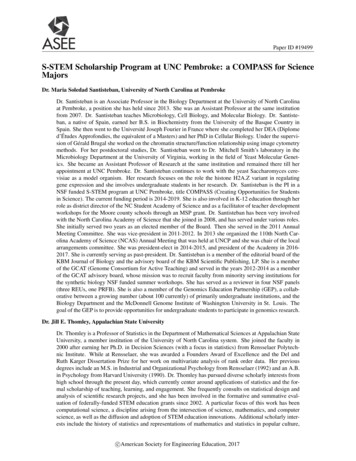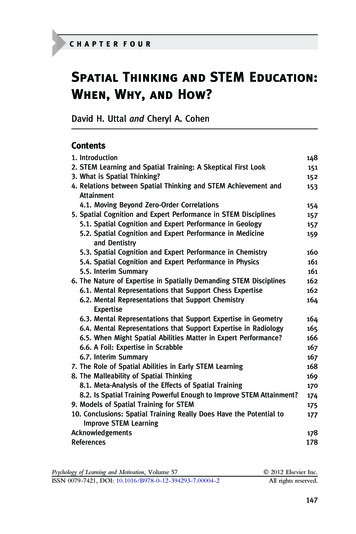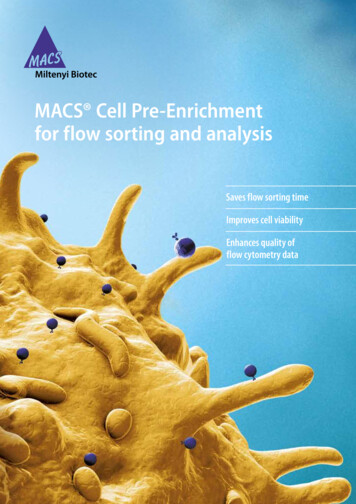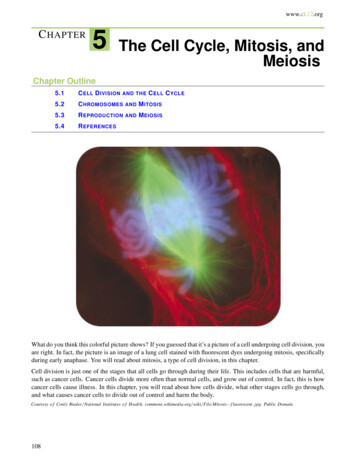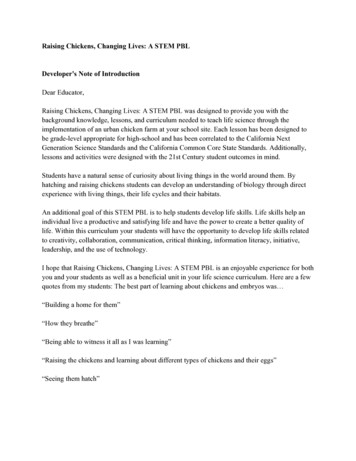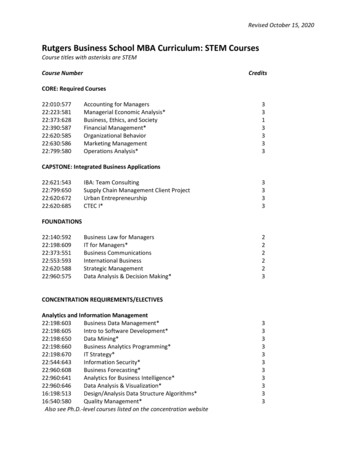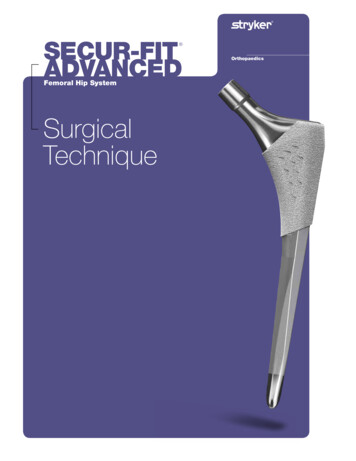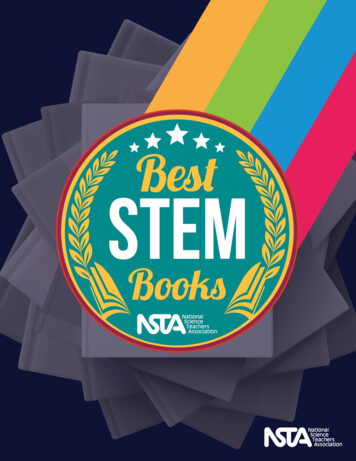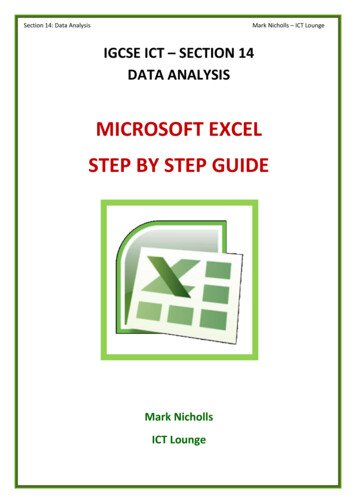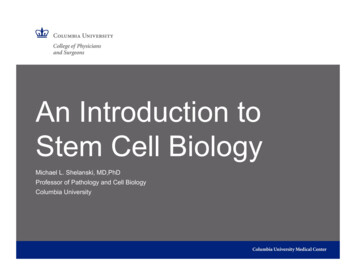
Transcription
An Introduction toStem Cell BiologyMichael L. Shelanski, MD,PhDProfessor of Pathology and Cell BiologyColumbia University
Figures adapted from ISSCR. Presentations ofDrs. Martin Pera (Monash University),Dr.Susan Kadereit, Children’s Hospital, Bostonand Dr. Catherine Verfaillie, University ofMinnesota
Science 1999, 283: 534-537PNAS 1999, 96: 14482-14486Turning Blood into Brain: Cells Bearing NeuronalAntigens Generated in Vitro from Bone MarrowScience 2000, 290:1779-1782Mezey, E., Chandross, K.J., Harta, G., Maki, R.A., McKercher, S.R.From Marrow to Brain: Expression ofNeuronal Phenotypes in Adult MiceScience 2000, 290:1775-1779Brazelton, T.R., Rossi, F.M., Keshet, G.I., Blau, H.M.Nature 2001, 410:701-705Nat Med 2000, 11: 1229-1234
Stem Cell FAQsDo you need to get one from an egg?Must you sacrifice an Embryo?What is an ES cell?What about adult stem cells or cord blood stem cellsWhy can’t this work be done in animals?Are “cures” on the horizon?Will this lead to human cloning – human spare parts factories?Are we going to make a Frankenstein?
What is a stem cell?A primitive cell which can either self renew(reproduce itself) or give rise to more specialised celltypesThe stem cell is the ancestor at the top of the familytree of related cell types. One blood stem cell givesrise to red cells, white cells and platelets
Stem Cells Vary in their Developmental capacityA multipotent cell can give rise to several types ofmature cellA pluripotent cell can give rise to all types of adulttissue cells plus extraembryonic tissue: cells whichsupport embryonic developmentA totipotent cell can give rise to a new individualgiven appropriate maternal support
The Fertilized EggThe “Ultimate” Stem Cell – the Newly Fertilized Egg (one Cell)will give rise to all the cells and tissues of the adult animal.Truly Totipotential but difficult to use.
Properties of humanES cellsThe defining feature of an ES cell is its ability to differentiate into a widerange of tissuesMartin F. Pera
Embryonic stem cellsDerived from five day old spare human embryosbefore specialised tissues of the body begin to formMay be grown indefinitely in culture in the primitiveembryonic stateRetain the property of pluripotency during extendedgrowth in vitroMartin F. Pera
Pluripotent cell populationsInner cell massEpiblastOocyteEmbryonalcarcinomaPrimordialgerm cellsMartin F. Pera
Properties of pluripotent stem cellsDerived directly and at high frequency from pluripotent cellpopulations in vivoGrow indefinitely in vitro (express telomerase)Maintain normal karyotypeCloned lines capable of differentiation into a wide range ofsomatic and extraembryonic tissues in vivo and in vitro-at highfrequency and under a range of conditionsCapable of colonising all tissues including germ line afterblastocyst injection to give chimeric offspringMartin F. Pera
Where do human embryonic stem cellscome from?ES cell colonyIVFExcessDestroyEmbryo bankMartin F. Pera
Early Stages of Human rine M. Verfaillie, University of Minnesota
Blastocyst stage of developmentBody plan not yet apparentMany cells will not form new human, but will give rise to tissuesuch as placenta which support pregnancyEmbryo does not yet necessarily represent a unique individual(twins can form up to 14 days)No precursors of nervous system present yetNot possible to predict whether embryo will be able to developto termMartin F. Pera
Establishment of ES cellsInner cell massES colony 10-15 days laterMartin F. Pera
Characterisation of primate pluripotent stem cellsImmunological markers: TRA1-60 and relatedepitopes, SSEA-3, SSEA-4Gene expression: transcripts for generic markers ofpluripotent stem cellsBiological properties: Differentiation into derivativesof all three germ layersMartin F. Pera
Human Embryonic Stem Cells (hESC)Derived from five day old spare human embryos created during IVF.Retain the property of pluripotency during extended culture growth: Unlimited supply for meaningful experiments. Can give rise to clinically relevant cell numbers.
What Actually Happens When Stem Cells Do“Their Thing”ALL SORTS OF THINGSLET’S TAKE A LOOK
Martin F. PeraTeratoma formed by human ES cells
ES cells give rise to disorganised growthscalled teratomasTeratomas do not display axisformation or segmentation.Unlike embryos, ES cells on theirown are incapable of generatingthe body plan.This lack of organisation is alsoseen when ES cells differentiatein vitroMartin F. Pera
ES cell differentiationCartilage, bone, skin,nerves, gut andrespiratory lining formwhen ES cells are injectedinto host animalsMartin F. Pera
Spontaneous ES cell differentiation in vitroStop ES cellmultiplicationES cellMixture of differentiatedCells with some pancreatic cells
Spontaneous ES cell differentiation in vitroMartin F. PeraNerve and muscle cellsare found in a complexmixture of many celltypes
Neural precursors can be derived from EScellsMartin F. Pera
Routes to differentiationCommitmentSignalES cellSpecific signals for growth anddifferentiationSelection and growthof committedprecursor cellProduction of large numbersof mature cell in pure formMartin F. Pera
How Do We Make A Stem Cell Into a Specific CellType?Need to understand biology of differentiationMuch Data Can be Derived from Animal ExperimentationUse growth factors and “differentiation agents”Key advantage is the ability to grow large quantities of “identical” cells
Studies of the mammalian embryoprovide clues as to how embryonic stemcell differentiation might be controlledMartin F. Pera
The embryo and ES cellsCell interactions between pluripotent cells andextraembryonic cells mediate patterning and fatedecisionsDo the same cell populations exist in ES cellcultures?Do the same molecules mediate fate decisions in EScell culture?Martin F. Pera
Cell types derived from human ES cells in vitroNerve, astrocyte, oligodendrocyteHematopoietic stem cellsInsulin producing cellsCardiomyocytesHepatocytesEndothelial cellsMartin F. Pera
Hematopoietic stem cells fromhuman ES cells (Kaufman et al.)Culture of ES cells on marrow stromal support linesleads to formation of CD34 hematopoietic precursorcellsWill form myeloid erythroid and megakaryocyticcolonies.Frequency 1-2%
Embryonic stem cells have important applications inbiomedical researchBasic studies of early human development and itsdisorders-birth defects, childhood cancersFunctional genomics in human cellsDiscovery of novel factors controlling tissueregeneration and repairIn vitro models for drug discovery and toxicologySource of tissue for transplantation medicineMartin F. Pera
Successful treatment of animal models of disease with mouse ES derivedcellsSevere immune deficiencyDiabetesParkinson’s diseaseSpinal injuryDemyelinationMyocardial infarctionMartin F. Pera
Challenges for transplantation therapyProduction of required cell type in sufficient numbersand pure formWhat cell to transplantDeliveryProblems of tissue rejectionMartin F. Pera
The immune rejection issuein ES cell based therapyHow immunogenic are embryonic or fetal derivedgrafts?Some transplantation sites will be immunologicallyprivilegedInteresting data to suggest embryonic cells caninduce tolerance in hosts Fandrich et al Nat. Med. 8:171, 2002Martin F. Pera
Solutions to the rejection problemLarge banks of ES cell linesManipulation of histocompatibility genes in ES cellsReplacement of hematopoietic/lymphoid tissue ofpatient with ES derived cells prior to transplantManipulation of T cell response with antibodies ordrugsTherapeutic cloning or related techniquesMartin F. Pera
Therapeutic cloningCombines cloning methods with embryonic stem celltechnology to produce cells which are custommade for patientA promising solution to problem of tissue rejectionUsed to produce ES cells in mice and cure a severeimmune disorderMore research may enable us to reprogram adultcells without going through embryo stepMartin F. Pera
Adult stem cellsProper tissue organisation and response to demands of growthor repair require that there be restrictions on developmentalpotential of adult stem cellsThese limits are strictly imposed by powerful molecularrestraints on gene expression and are heritable during manyrounds of cell divisionAn adult stem cell may show relaxation of these restrictions inan altered environment, possibly accounting for plasticity.Even so, plasticity is observed usually at low frequencyMartin F. Pera
Bone Marrow Stem Cells isolated from human, mouse and rat. Appear only after 35 population doublings. Can be grown to 50-80 population doublings. Give rise to mesoderm, neuroectoderm and endoderm Can form chimeras with cells in all somatic tissues, when injectedinto blastocysts (multipotent).
Cord Blood Stem Cells rare cell, CD45 / HLA Grow robustly in vitro without differentiating. Give rise to mesoderm, neuroectoderm and endoderm. In vivo: differentiation into neural cells, bone andcartilage,blood, myocardial cellsand Purkinje fibers, hepatic cells.
Nuclear TransferTo produce cells which are custom made for patient.A promising solution to problem of tissue rejection, as cells express thepatients genes.Embryonic stem cell lines created from patients with certain diseases, tostudy disease development and to develop drugs.
Therapeutic cloning in transplantation: necessary or feasible?How severe will immune rejection problem be?Other solutions exist to the problemIs it practical? Where will the eggs come from? Canthe procedure be turned around in the required timeframe?Is it safe? Is it easier to make normal cells fromcloned ES than to make normal animals?Martin F. Pera
Nuclear TransferADBECFMark Denham & Richard Mollard, Monash University
Problems withNuclear Transfer (NT) Inefficient: 242 30 blastocysts 1 cell line Time to derive therapeutic cells from NT blastocysts will takeseveral weeks to months.
Somatic Cell Nuclear TransferES cellsCells eg skinProblems: Inefficient (may need hundreds of eggs)Technically demanding - need to be available inmany or all hospitalsMartin F. PeraSource of eggs: Self,Mother, Relative, EggbankCompatibletransplants
ARE THERE WAYS AROUND USING EGGS ANDEMBRYOS?POSSIBLY
Reprogramming without using an egg or making anembryoIn futureNowPluripotent cellAdult cellAdult cellCell fusionHybrid cell shows activationof embryonic genomeInject proteinsfrom pluripotentcell or eggadult cell becomespluripotentMartin F. Pera
Do We Have the Ability to Repair Ourselves?Endogenous Stem CellsNeed to learn to manipulate in the bodyIndications from hematology that is possible
Cancer Stem Cells Not all the cells within a tumor can maintain tumor growth,most cancers are not clonal. Several long-known oncogenic pathways are pivotal to themaintenance of normal stem cell self-renewal. Techniques used in the stem cell field have identified selfrenewing cells. By identifying the stem cells in tumors, it could beshown that only the cancer stem cells propagated the tumor.
Cancer Stem Cells In breast cancer, brain tumors, certain forms of leukemia, andgastric tumor. Unknown whether the tissue stem cell degenerates, or if a moredifferentiated cell reacquires stem cell phenotype. Despite preventive mechanisms adult stem cells mayaccumulate mutations over the years.
Why we need new stem cell linesPanels of cell lines required for tissue matching intransplantationSafety hazards with current cells derived using animal tissueCurrent bona fide lines few in number; improvements totechniques will enable production of second generation EScells with better properties;Need cell lines in the public domain without commercialrestrictions on useMartin F. Pera
Are We Making a Frankenstein?Not That DramaticBut, Beware of hypeRemember the Law of Unintended Consequences
Not all the cells within a tumor can maintain tumor growth, most cancers are not clonal. Several long-known oncogenic pathways are pivotal to the maintenance of normal stem cell self-renewal. Techniques used in the stem cell field have identified self-renewing cel
